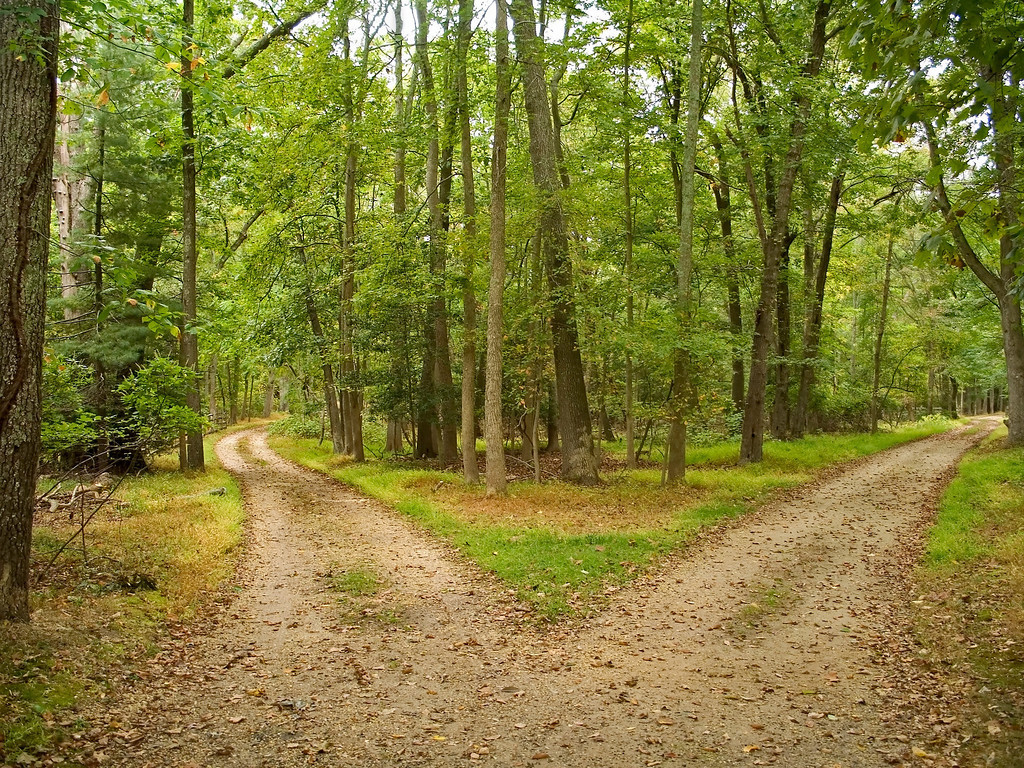". . . yet knowing how way leads on to way . . . " - from Robert Frost's "The Road Not Taken"
2/10/19, 12:22 PM
By: Julie Rockefeller

". . . yet knowing how way leads on to way . . . " - from Robert Frost's "The Road Not Taken"
"The Road Not Taken" is perhaps Robert Frost's most well-known poem. In it he describes a traveler's choice between two roads and reflects on the impact of such a small decision. Or rather, he reflects on the likelihood that one day he'll look back and imagine that opting for one road instead of the other will have "made all the difference". The poem's imagery is strong, and I can see Frost standing there at the fork, deliberating. I can see, too, the wistful, older man asking himself, "What if?". The wooded road is a metaphor for the human experience. We move forward making decisions, living with the consequences.
Frost was making a conscious choice, evaluating two roads that seemed fairly equal at the beginning. He was ignorant of either probable outcome, but well aware that he was making a decision.
But what about those times we choose a path not knowing that others are available to us? What about all the decisions we make completely unawares?
I learned to knit when I was 18 years old. I wanted to make a gift for my friend's new baby, so I went to a shop, chose a pattern, and bought the supplies listed. The pattern came with "how to knit" instructions printed on the back page. In complete ignorance, then, on the very first day of my knitting life, I made a major decision: I learned to knit using the English method of knitting rather than the Continental method. And I have lived with consequences of that decision for the intervening 38 years.
It was not until another knitter asked me, "Who taught you how to knit?", with her nose crinkled up in distaste, that I even knew there was another option. When she showed me the alternative method, I did think it looked more efficient, but by then I was not interested in learning new mechanics. I didn't want to go back and begin again, no matter the alleged benefits. The way I had "chosen" was perfectly fine with me.
When I decided that I wanted to become a very good knitter, I understood that I needed to master the alternative method of knitting and make a deliberate choice between the two. In other words, I needed to travel back in time to that moment when the fork (invisible as it was to me) had appeared. I needed to explore the other path, compare it with the first, and make my choice.
Sparing you the details of this laborious process, during which I railed against the time it took and struggled mightily with the aggravation it provided, I can now (almost) as competently "pick" my stitches as "throw" them. A hard won victory, indeed. Muscle memory is a powerful adversary.
So which method did I choose? Well, this is the moment when the divergent roads metaphor breaks down.
Once Frost made up his mind which to follow, he paused to reflect before stepping out:
"Oh, I kept the first for another day!
Yet knowing how way leads on to way,
I doubted if I should ever come back."
In the case of me and my knitting, I discovered that the two methods are equally good. I am a more productive knitter because I can do both. From an ergonomic standpoint, it is good to be able to replace one repetitive motion with another, and there are situations in which one method produces nicer results with less fuss than the other. In effect, then, I am now traveling both roads at the same time. Or perhaps more accurately, I have combined two smaller roads into a wider thoroughfare.
More important than merely gaining knitting efficiency, however, the experience of traveling back in time to stand again at that fork in the road taught me to look for "invisible choices" when I am asked to make a decision or take action. What options exist that I don't even know about? Is there some hidden way unknown to me?


